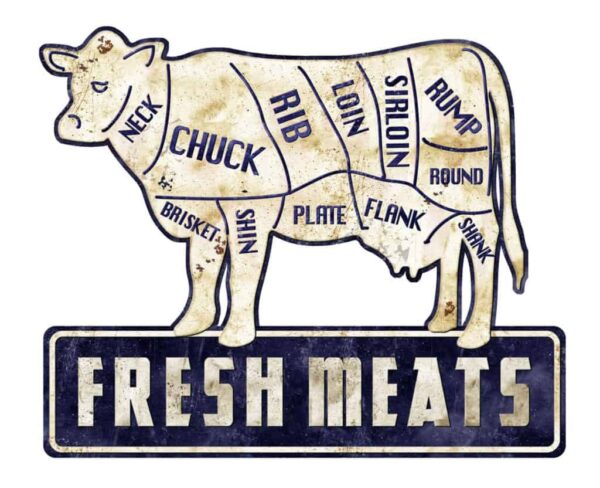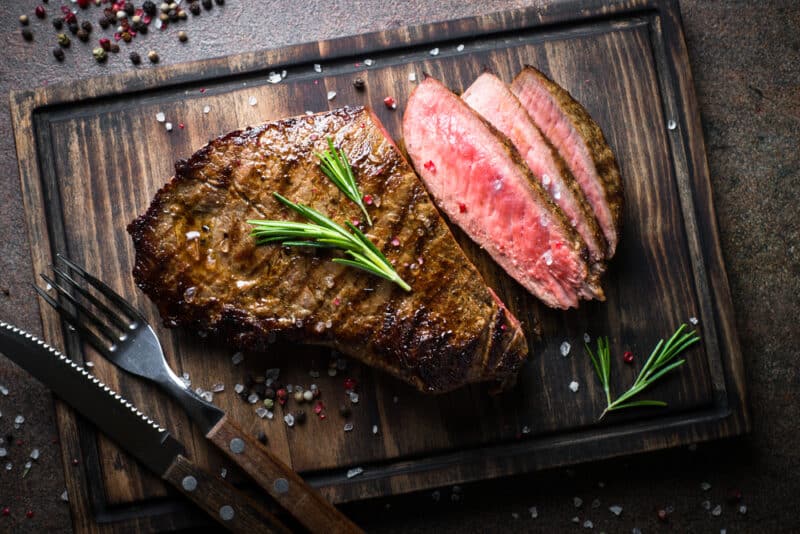What Part of the Cow is Brisket From? (Includes Resources)
TheGrillingMaster.com is reader-supported. If you buy something using the links on our site, we might earn an affiliate commission at no added cost to you. This helps us pay our staff to keep making awesome content for you!

Brisket is sourced from the breast section or the lower chest area of the cow. Positioned at the front of the cow, it is nestled between the shoulder and the belly. The muscles in this area are frequently used, which imparts the meat with its distinctively fibrous and robust texture.
Counted among the nine primary cuts of beef, brisket is also heralded as one of the four essential
cuts for barbecue. It’s composed of muscle that’s richly marbled with fat and abundant in tough connective tissues and collagen. For this reason, a slow and prolonged cooking process is essential.
Anatomy of a Cow: An Overview
Alright, my fellow barbecue lovers, let’s delve into the anatomy of the cow in an organized manner. We’ll walk through each major section, numbered, so you can easily refer back when you need to.

Image credit to: bbqhost.com/what-part-of-the-cow-is-brisket
The major sections of beef cuts:
-
Chuck Situated around the shoulder and neck area, chuck cuts are robust in flavor but can be somewhat tough. This section is excellent for stews, pot roasts, and, let me tell you, divine pulled beef sandwiches. Chuck is like a warm hug on a cold day; it’s comfort food at its best.
-
Rib Next, at number two, we have the ribs. Can we even talk about barbecue without mentioning ribs? Marbling is the rib section’s middle name, making it incredibly tender and succulent. From ribeye steaks to prime rib, this section is synonymous with indulgence.
-
Loin At number three, we find the loin. This is the VIP section, folks. It’s tender, lean, and just asking to be grilled. If you’ve ever savored a Filet mignon or T-bone steak, you know exactly why this cut is beloved by steak enthusiasts.
-
Round Number four is the round section, found in the cow’s hind leg. It’s on the leaner side and not as tender as some other cuts, but it’s fantastic for roasts and thinly sliced steaks. It’s versatile and reliable – a true friend in the kitchen.
-
Flank Coming in at number five, we have the flank. This is abdominal muscle territory. It’s a brilliant cut for grilling but remember to slice it against the grain to maximize tenderness. This is your go-to for fajitas and stir-fries.
-
Short Plate Number six introduces us to the short plate. This underbelly cut is fatty and packed with flavor. Skirt steak calls this section home, and it’s a favorite for fajitas and the classic Philly cheesesteak.
-
Brisket Ah, the guest of honor at number seven – the brisket. We’ll be exploring this one in glorious detail later, but for now, know that it’s the breast section of the cow and a barbecue superstar.
-
Shank Finally, at number eight, we have the shank. This is leg country and is one tough customer. But, slow cook it, and you’re rewarded with rich, flavorful dishes. If you’ve ever had Ossobuco, you know the magic of the shank.
The Brisket Cut: Zooming In
Now that we’ve navigated through the landscape of the cow’s anatomy, it’s time to zoom in on our treasure – the brisket. If barbecue were a symphony, brisket would undoubtedly be the crescendo. A cut that, when handled with love and patience, rewards you with flavors that are simply celestial.
Let’s begin by pinpointing exactly where the brisket is situated.
Brisket comes from the breast section, just below the chuck. The brisket is essentially the pectoral muscles of the cow. Given that these muscles support much of the cow’s weight, they are well-exercised. This results in a substantial amount of connective tissue and muscle fibers, giving the brisket its characteristic tough texture.
Let’s break the brisket down further.
There are two sub-primal cuts of the brisket that you might come across at the butcher shop: the flat cut and the point cut. The flat cut, also known as the first cut, is comparatively leaner. It’s a bit more uniform in shape, which makes it a darling for those delightful slices you see in a Texas-style barbecue. The point cut, or second cut, is richer in fat content and has a slightly more irregular shape. If you’re looking for that melt-in-your-mouth, buttery texture, the point cut is your cut.
What makes the brisket such an enigma in the world of barbecue?
It’s the interplay of muscle fibers, connective tissues, and fat. Brisket has an intrinsic, beefy flavor that is truly distinct. It’s like the cow’s hard work in roaming the pastures is encapsulated in this cut. However, unlocking this flavor is an art.
One might be tempted to simply grill it hot and fast, but the real magic with brisket lies in a slow and low approach. The long cooking process allows the collagen within the connective tissues to break down and gelatinize. This process is the alchemy that transforms a tough cut into a tender, juicy, flavor-packed delight.
Understanding the brisket’s anatomy also enables you to refine your technique. For instance, knowing how the muscle fibers are aligned will guide you in slicing the meat in a way that yields the most tender bite. Yes, with brisket, even the slicing is an art!

The Significance of Brisket in Barbecue
Alright friends, we’ve arrived at the practical segment of our brisket journey.
It’s time to put on our aprons and fire up the grill! I’m eager to share with you some trade secrets that have been passed down through generations of barbecue masters. These tips and techniques will elevate your brisket game to legendary status.
First and foremost: selecting the right piece of brisket is key.
Look for a cut with a thick layer of fat on one side, known as the fat cap. This fat will slowly render as you cook, basting the meat in its own juices. Don’t worry about the fat content; this is what makes the brisket so tender and flavorful. The best brisket also has a deep red color, with white marbling running through it.
Let’s talk about seasoning.
Some people like to get fancy with rubs and marinades, but I’m a purist.
Give me good old salt and pepper, and I’m in brisket heaven. Generously season your brisket with coarse salt and freshly cracked black pepper. This classic combo will enhance the natural beefy goodness of the brisket without overpowering it.
Now, it’s time to talk about the main event – cooking. Low and slow is the mantra here.
Set your grill or smoker to a temperature range of 225 to 250 degrees Fahrenheit. Patience is your ally; don’t try to rush the process. A general rule of thumb is to cook the brisket for about 1 to 1.5 hours per pound. So, if you’ve got a 10-pound brisket, you’re in for a 10 to 15-hour adventure.
Read more about more tips and tricks when it comes to smoking brisket.
Let’s not forget about resting.
Once your brisket reaches an internal temperature of around 200 degrees Fahrenheit, remove it from the grill and let it rest for at least an hour. This allows the juices to redistribute throughout the meat.
Lastly, as we discussed earlier, slicing is an art. Always slice against the grain to ensure the most tender bite.

Brisket Sauces and Side Dishes
At this juncture of our brisket escapade, we must address a critical aspect that turns a good brisket into an exceptional one – the sauces and accompaniments. The brisket is the star of the show, but like any good lead, it shines even brighter with a stellar supporting cast. Let’s get saucy!
Sauces: When it comes to sauces, regional preferences can be quite pronounced. Here’s a breakdown of some classic options:
- Texas-style Sauce: Texans often go for a thinner sauce, with a ketchup or tomato base, spiced up with ingredients like cumin, chili, and black pepper. It’s tangy, slightly spicy, and compliments the beef perfectly.
- Kansas City Sauce: This one is thicker and sweeter. It’s a tomato-based sauce with a good helping of molasses or brown sugar. This rich and sticky sauce is great for those who love a sweet and savory combo.
- South Carolina Mustard Sauce: This sauce is mustard-based, with vinegar, sugar, and spices. It’s tangy, sweet, and a bit spicy, providing a zesty counterbalance to the rich flavors of the brisket.
Feel free to experiment and even blend different styles to create your own signature sauce.
Accompaniments: A well-rounded brisket meal also features some delicious sides. Here are a few classics:
- Coleslaw: A tangy, crunchy coleslaw cuts through the richness of the brisket and refreshes your palate.
- Potato Salad: Creamy potato salad is a classic accompaniment. You can go for a mayo-based one or try it with a vinegar dressing.
- Pickles: Simple but effective. The acidity and crunch of pickles are a perfect contrast to the tender, juicy meat.
- Cornbread: Sweet, moist cornbread is just divine with brisket. It’s like they were made for each other.
And keep in mind that pairing your brisket with the perfect dink is key!
International Brisket Dishes
The mighty brisket, while heralded as a barbecue champion, has the versatility to be a key player in an array of dishes. Here, I’ll share some creative ways to use brisket that may just become your new favorites. Fasten your aprons; we’re about to embark on a global brisket adventure!
1. Brisket Tacos: Ah, let’s take a detour down to the vibrant streets of Mexico. Brisket makes for an incredible taco filling.
- How to Make: Take your smoked brisket, shred it, and toss it in a skillet with a bit of oil, sautéed onions, and your favorite taco seasoning. Load it into warm tortillas and top with salsa, guacamole, cheese, and a squeeze of lime.
2. Brisket Ramen: We’re heading to Japan! Transform leftover brisket into a sumptuous bowl of ramen.
- How to Make: Use a rich beef broth as the base. Add in soy sauce, miso paste, and a dash of sesame oil. Place cooked ramen noodles in the bowl, top with slices of brisket, a soft-boiled egg, green onions, and a sprinkle of sesame seeds.
3. Brisket Poutine: Let’s make our way to Canada with this indulgent treat.
- How to Make: Start with a bed of crispy fries. Add cheese curds and then lay on generous chunks of brisket. Finally, smother everything in a rich gravy. This is comfort food at its finest.
4. Brisket Bao Buns: Taking inspiration from China, this one’s a showstopper.
- How to Make: Steam some bao buns until they’re fluffy. Fill them with slices of brisket, pickled vegetables, hoisin sauce, and fresh cilantro.
5. Brisket Shepherd’s Pie: A classic with a twist, all the way from the British Isles.
- How to Make: In a baking dish, layer shredded brisket that’s been mixed with gravy and veggies. Top it with a generous layer of mashed potatoes, then bake until golden and bubbly.
6. Brisket Stuffed Bell Peppers: A homestyle favorite with a hearty filling.
- How to Make: Hollow out bell peppers and set them aside. Mix shredded brisket with cooked rice, tomatoes, onions, and spices. Fill the bell peppers with this mixture, top with cheese, and bake.

Troubleshooting Common Brisket Pitfalls
As much as we wish our brisket adventures to be flawless, sometimes the BBQ gods challenge us with some hurdles.
Fear not, for I shall arm you with the wisdom to overcome these common brisket pitfalls.
A. Avoiding Dryness: Nothing breaks a Grilling Master’s heart quite like slicing into a beautiful brisket only to find it as dry as the Sahara. Here’s how we can outsmart dryness:
- Fat Cap Up: Place your brisket fat side up. As it cooks, the fat will melt and baste the meat.
- The Spritz Technique: Keep a spray bottle filled with apple cider vinegar or beef broth. Gently spritz your brisket every hour during the cooking process.
- Wrapping it Up: When the brisket hits around 150-160 degrees Fahrenheit, wrap it in butcher paper or aluminum foil. This technique, sometimes called the Texas Crutch, helps to lock in moisture.
- Rest, Rest, Rest: Let your brisket rest wrapped for at least an hour after cooking. This allows the juices to redistribute throughout the meat.
B. Dealing with a Tough Texture: If your brisket is putting up a fight against your teeth, it’s time to make it surrender to tenderness:
- Low and Slow: Toughness is often due to cooking too fast. Remember, low and slow is the mantra – around 225-250 degrees Fahrenheit.
- Marinate with Acids: Using a marinade with some acidic elements like vinegar or citrus helps to break down some of the tough fibers.
- Slicing Matters: Always slice against the grain. This shortens the muscle fibers and makes the meat easier to chew.
C. Adjusting Cooking Times and Temperature: Finding the sweet spot for cooking times and temperatures can be tricky. Here are some tips:
- Know Your Cut: A whole packer brisket will take longer than just the flat or the point. Generally, estimate between 1 to 1.5 hours per pound.
- Use a Thermometer: Don’t rely on time alone. Use a good meat thermometer to monitor the internal temperature. Aim for around 200-203 degrees Fahrenheit for optimum tenderness.
- Adjust for Weather: If you’re smoking outdoors, the weather can affect your cooking times. Cold weather may require a slightly higher temperature setting, while hot weather might require a bit lower.
Brisket FAQs
-
What is brisket, and where does it come from?
Brisket is a cut of beef that comes from the breast or lower chest area of the cow.
-
What makes brisket a challenging cut to cook?
Brisket is a tough cut of meat due to its high collagen content and dense muscle fibers, requiring slow and low cooking methods to achieve tenderness.
-
What is the difference between the flat and point cuts of brisket?
The flat cut, also known as the “lean” or “first cut,” is a leaner and more uniform portion of the brisket, while the point cut, also called the “deckle” or “second cut,” has more marbling and fat, resulting in a juicier and flavorful meat.
-
What is the ideal internal temperature for a perfectly cooked brisket?
Aim for an internal temperature of around 203 degrees Fahrenheit (95 degrees Celsius) to ensure the collagen has sufficiently broken down, resulting in tender and melt-in-your-mouth brisket.
-
How long does it take to smoke a brisket?
Smoking a brisket can take anywhere from 10 to 14 hours, depending on the size of the cut, the cooking temperature, and the desired level of tenderness.
-
What is the “stall” during brisket cooking, and how can it be overcome?
The “stall” is a period during cooking when the brisket’s internal temperature plateaus. To overcome it, you can wrap the brisket in foil or butcher paper, which helps to push through the stall and speed up cooking.
-
Can I cook a brisket in the oven instead of a smoker?
Yes, you can cook a brisket in the oven by using similar low and slow techniques, such as maintaining a low cooking temperature and using a braising liquid to keep the meat moist.
-
How should I slice a brisket for optimal tenderness?
Always slice brisket against the grain to shorten the muscle fibers, resulting in a more tender bite. Slicing with the grain can make the meat tougher.
-
How should I store leftover brisket?
Allow the brisket to cool completely, then wrap it tightly in foil or place it in an airtight container. It can be stored in the refrigerator for up to four days or frozen for longer-term storage.
-
Are there alternative cuts of meat that can be used as a substitute for brisket?
While no cut is an exact substitute, beef chuck roast or short ribs can be used in certain recipes as alternatives to brisket. They require similar cooking methods to achieve tenderness.
Learn More About Grilling
If you want to learn more about grilling, check out these other helpful resources!

Patrick Harvey
Patrick is a life long grilling enthusiast with an eye for product development and user experience. His expertise helps us test and review all of the products you see the website.
About The Grilling Master
Hi there, I'm Kevin Turner, Founder and CEO of thegrillingmaster.com.
My passion has always been grilling, smoking and BBQ delicious meats that satisfy my inner carnivore!
I started this website to share my passion and knowledge with you, the hungry reader who wants to prepare the perfect meal.
You can leverage my years of experience as a pit master and professional.
Send me a message and let's connect on Twitter here.

















